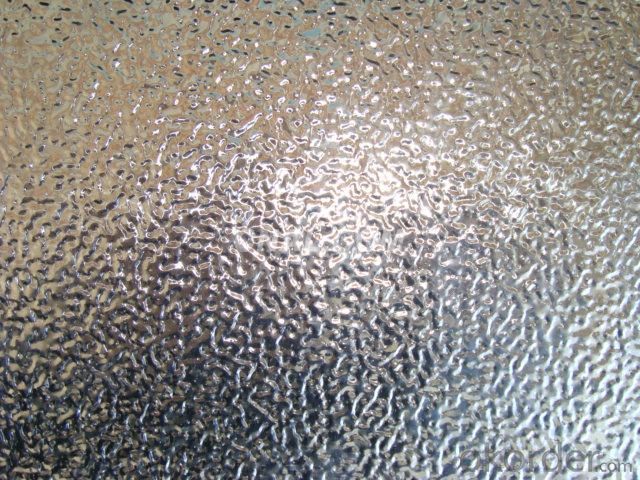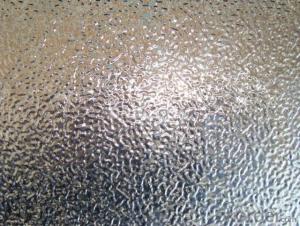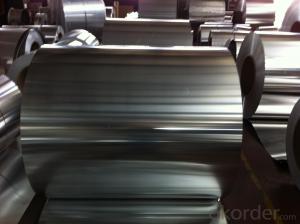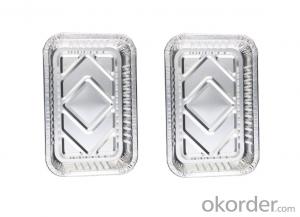Coated Aluminum Stucco Embossed Sheet /Coil
- Loading Port:
- Shanghai
- Payment Terms:
- TT OR LC
- Min Order Qty:
- 5 m.t
- Supply Capability:
- 5000 m.t/month
OKorder Service Pledge
Quality Product, Order Online Tracking, Timely Delivery
OKorder Financial Service
Credit Rating, Credit Services, Credit Purchasing
You Might Also Like
Specifications
coated aluminum stucco embossed sheet
1.flat, cleaned, bright no oil stain
2.using in bus, cars and shipping vessel as the
1.Features for coated aluminum stucco embossed sheet :
1) Alloy: AA1050, AA1060, AA1070, AA3003
2) Temper: H14, H16, H18, H24, H26, H28, H34, H36, H38
3) Thickness: 1.20mm - 5.00mm
4) Width: 1000 ~ 1250mm
5) Length of sheet: 1000mm ~ 4000mm
Packing for coated aluminum stucco embossed sheet
Covering with plastic film and brown paper and then packed with wooden
package, directly loading into container for transshipment.
Good elongation anticorrosion
Dimensions can be produced depend on customise

- Q:What are the different methods of surface preparation for aluminum sheets?
- There are several methods of surface preparation that can be used for aluminum sheets. These methods are designed to clean, treat, and prepare the surface of the aluminum to ensure optimal adhesion and paint durability. Here are some of the different methods of surface preparation for aluminum sheets: 1. Mechanical Abrasion: This method involves using abrasive materials such as sandpaper, wire brushes, or sandblasting to physically remove any dirt, rust, or oxidation from the surface of the aluminum. Mechanical abrasion creates a rough texture on the surface, which promotes paint adhesion. 2. Chemical Cleaning: Chemical cleaning involves using acidic or alkaline solutions to remove any contaminants or oxidation from the surface of the aluminum. This method is particularly effective for removing tough stains, oils, or greases. The surface is typically rinsed thoroughly after chemical cleaning to remove any residue. 3. Etching: Etching is a process that involves applying an acidic or alkaline solution to the aluminum surface to create a microscopically rough texture. This rough surface enhances paint adhesion and provides a better bonding surface for coatings. Etching is commonly used as a pre-treatment before applying a primer or paint. 4. Conversion Coating: Conversion coating is a surface treatment method that involves applying a chemical solution to the aluminum surface to create a thin, protective layer. This layer not only improves paint adhesion but also provides corrosion resistance. Common conversion coatings for aluminum include chromate conversion coatings and phosphoric acid anodizing. 5. Mechanical Cleaning: Mechanical cleaning involves using mechanical methods such as brushing, scraping, or buffing to remove loose particles, dirt, or debris from the surface of the aluminum. This method is often used as a preliminary step before applying other surface treatments or coatings. It is important to note that the choice of surface preparation method may vary depending on the specific requirements of the aluminum sheet's application, the condition of the surface, and the desired finish. Proper surface preparation is crucial to ensure the longevity and performance of the paint or coating applied to aluminum sheets.
- Q:What keeps things colder- plastic wrap or aluminum foil?
- Aluminum foil. It is thicker, and metal retains heat/cold longer than the thin film of plastic would. I actually use both when I freeze things like lasagna...I use a layer of plastic wrap on it first, then a layer of foil over the top. It creates an extra (albeit fine) layer of insulation.
- Q:Can aluminum sheets be used for solar reflectors?
- Yes, aluminum sheets can be used for solar reflectors. Aluminum has a high reflectivity, meaning it can effectively reflect sunlight and reduce heat absorption. This makes it an ideal material for solar reflectors, which redirect and concentrate sunlight onto solar cells or other energy-absorbing devices.
- Q:Can aluminum sheets be used for electronic enclosures?
- Yes, aluminum sheets can be used for electronic enclosures. Aluminum is a commonly used material for electronic enclosures due to its excellent properties. It is lightweight, corrosion-resistant, and provides good electromagnetic shielding. Aluminum sheets can be easily formed and fabricated into various shapes and sizes, making them suitable for housing electronic components. Furthermore, aluminum has good thermal conductivity, allowing for efficient heat dissipation from the enclosed electronics. Overall, aluminum sheets are a popular choice for electronic enclosures due to their durability, versatility, and electrical properties.
- Q:How thick can aluminum sheets be?
- Aluminum sheets can vary in thickness, ranging from as thin as 0.006 inches (0.15mm) to as thick as 0.5 inches (12.7mm) or more, depending on the specific requirements and applications.
- Q:Are aluminum sheets suitable for beverage cans?
- Yes, aluminum sheets are suitable for beverage cans. Aluminum is a widely used material in the beverage industry due to its unique properties. It is lightweight, corrosion-resistant, and provides an excellent barrier against light, oxygen, and moisture, which helps to preserve the quality and freshness of the beverage. Additionally, aluminum is easily formable, allowing for the production of various can shapes and sizes. It is also recyclable, making it an environmentally friendly choice. Overall, aluminum sheets are an ideal material for beverage cans, meeting both functional and sustainability requirements.
- Q:What is aluminium plate L2-Y2?
- China plastic deformation of pure aluminum grades are 1080, 1080A, 1070, 107000A (L1), 1370, 1060, 1050 (L2), 1050A (L3), 1A50 (LB2), 1350, 1145, 1035 (L4), 1A30 (L4-1), 1100 (L5-1), 1200 (L-5), 1235. Iron and silicon are their major impurities and are increasing by the number of brands.2, Y2: indicates that the material is in a semi hard state
- Q:What are the different alloys available for aluminum sheets?
- Aluminum sheets offer a range of options when it comes to alloys, each with its own distinct properties and uses. Let's take a look at some of the most commonly used alloys: 1. 1100: This alloy is pure aluminum and boasts exceptional resistance to corrosion. It is perfect for applications that demand high levels of protection against corrosion, such as marine environments. 2. 3003: Another alloy that is purely aluminum, 3003 offers good formability, moderate strength, and high resistance to corrosion. It finds its place in general sheet metal work, chemical equipment, and cooking utensils. 3. 5052: Known for its impressive fatigue strength and outstanding resistance to corrosion, especially in saltwater settings, this alloy is often employed in marine applications, as well as aircraft components and fuel tanks. 4. 6061: As a heat-treatable alloy, 6061 showcases excellent weldability and formability, along with elevated strength and superb corrosion resistance. It is commonly utilized in structural components like frames, railings, and automotive parts. 5. 7075: This alloy stands out for its remarkable strength-to-weight ratio, making it perfect for aerospace applications and structural components that face high levels of stress. However, it is less resistant to corrosion than other alloys and may require protective coatings in specific environments. These examples represent only a fraction of the aluminum sheet alloys available. The choice of alloy relies on the specific requirements of the application, considering factors such as strength, corrosion resistance, formability, and cost. It is crucial to consult a knowledgeable supplier or engineer to determine the most appropriate alloy for your particular needs.
- Q:What kind of pattern aluminium plate has?
- Aluminum alloy decorative plate: aluminum alloy perforated sound absorption boardThe aluminum alloy perforated plate is made of various aluminum alloy plates and punched by machine. Pass a round hole, square hole, round hole, square hole, triangle hole according to the needs of small hole combination. This is a new product that reduces noise and has an ornamental effect. Aluminum Alloy perforated plate material is light, high temperature resistance, corrosion resistance, fire resistance, moisture-proof, shock proof, good chemical stability, beautiful appearance, elegant color, three-dimensional sense of strong, good decorative effect, and is convenient to assemble and can be used in hotels, restaurants, cinemas, studios and other public buildings.
- Q:Are 101 aluminum sheets suitable for automotive applications?
- Indeed, automotive applications are well-suited for 101 aluminum sheets. This alloy, known for its high-strength composition, boasts impressive formability, corrosion resistance, and exceptional weldability. These attributes render it a favored selection for a range of automotive elements, including body panels, heat shields, and structural parts. Furthermore, the lightweight nature of 101 aluminum sheets aids in enhancing fuel efficiency and overall vehicle performance. In summary, the strength, formability, corrosion resistance, weldability, and lightweight characteristics of 101 aluminum sheets make them a highly suitable choice for automotive applications.
1. Manufacturer Overview |
|
|---|---|
| Location | |
| Year Established | |
| Annual Output Value | |
| Main Markets | |
| Company Certifications | |
2. Manufacturer Certificates |
|
|---|---|
| a) Certification Name | |
| Range | |
| Reference | |
| Validity Period | |
3. Manufacturer Capability |
|
|---|---|
| a)Trade Capacity | |
| Nearest Port | |
| Export Percentage | |
| No.of Employees in Trade Department | |
| Language Spoken: | |
| b)Factory Information | |
| Factory Size: | |
| No. of Production Lines | |
| Contract Manufacturing | |
| Product Price Range | |
Send your message to us
Coated Aluminum Stucco Embossed Sheet /Coil
- Loading Port:
- Shanghai
- Payment Terms:
- TT OR LC
- Min Order Qty:
- 5 m.t
- Supply Capability:
- 5000 m.t/month
OKorder Service Pledge
Quality Product, Order Online Tracking, Timely Delivery
OKorder Financial Service
Credit Rating, Credit Services, Credit Purchasing
Similar products
New products
Hot products
Hot Searches
Related keywords




























